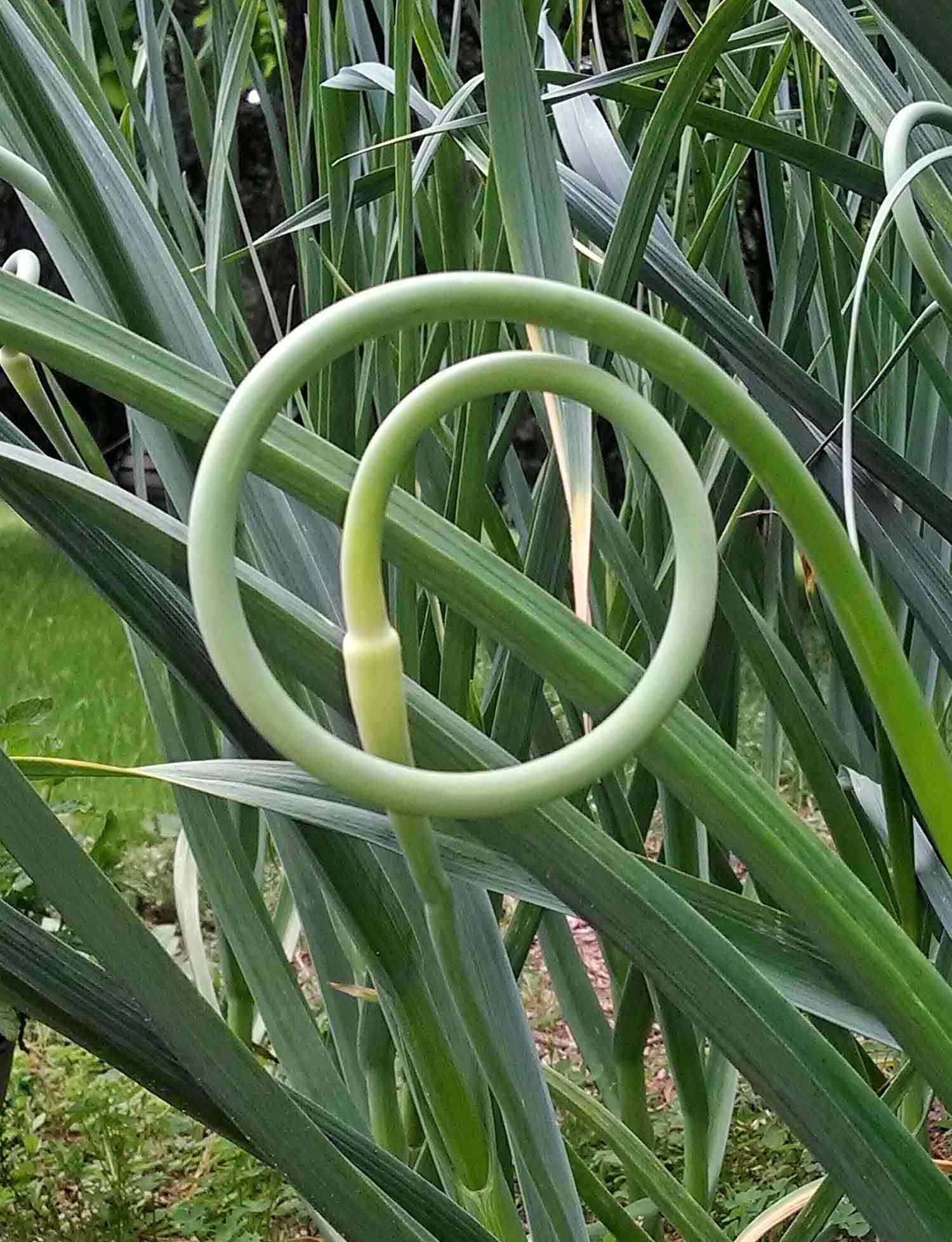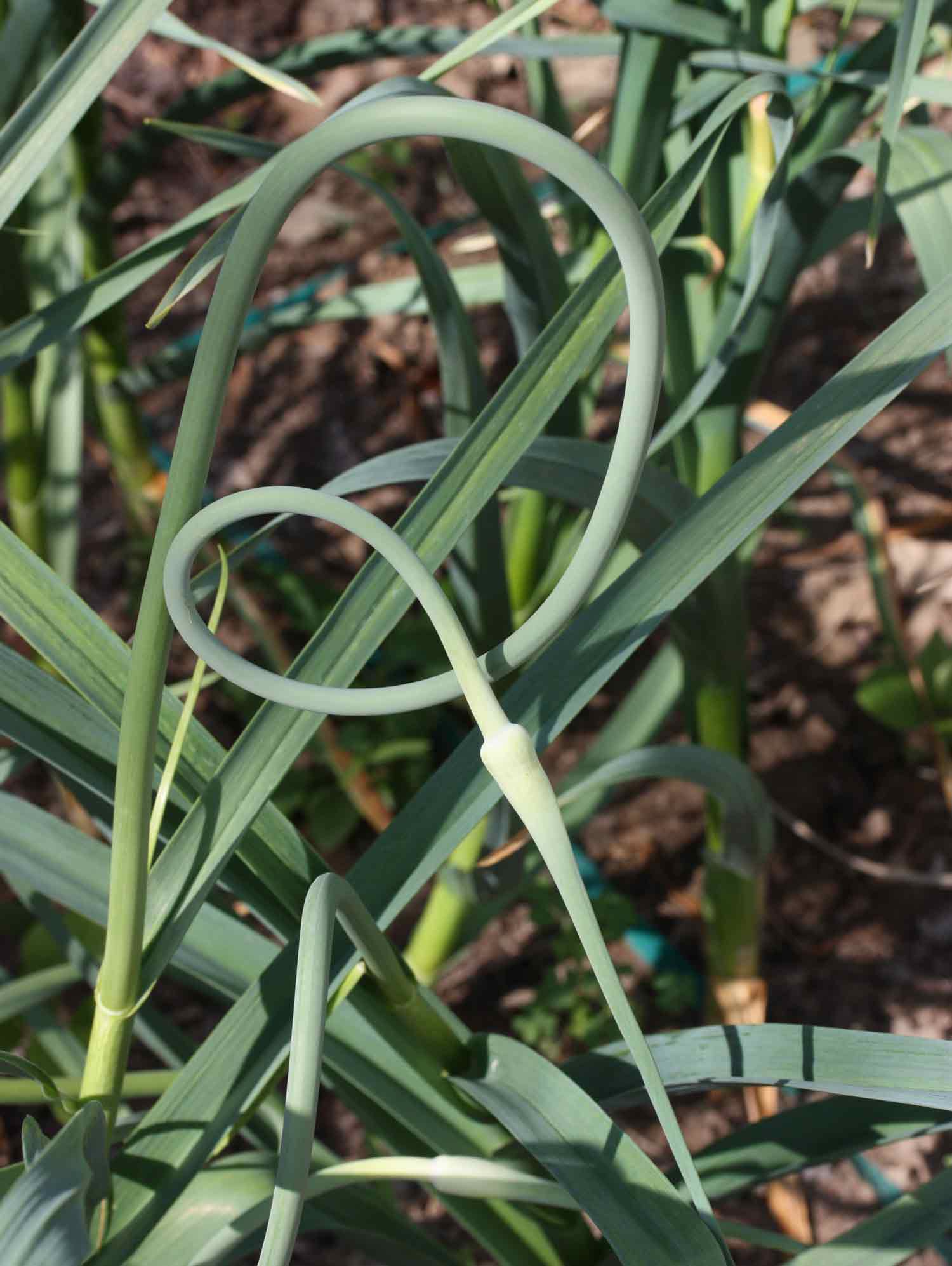As the weather warms up and spring turns into summer, hardneck garlic bulbs begin to produce a happy bonus: garlic scapes. These curly, green shoots are not only edible, but they’re also a unique and delicious seasonal treat. In this article, we’ll explore the joy of harvesting and using garlic scapes. So roll up your sleeves, grab your sheers, and let’s dive into the wonderful world of garlic scapes!

It’s no secret that I’m a huge fan of growing garlic at home. I’ve grown garlic for over 15 years, and it’s one of my very favorite crops, both as a gardener and a home cook.
It’s also one of the most low-maintenance crops I grow, as you plant cloves in the fall and wait for them as patiently as you can to emerge in the spring, where they pretty much take care of themselves until harvest in early summer.
So when new gardeners ask me what they should grow, I immediately answer: garlic.
What’s little known outside of the gardening and farming world, however, is that more than the garlic bulb is edible. Some varieties of garlic produce flowering heads, and both the heads and the stalks they grow from are edible.
The stalks are called garlic scapes, and their short, once-a-year season makes them prized ingredients by cooks and chefs everywhere. Scapes have the firmness of asparagus, with a mild garlic flavor.

What are Garlic Scapes?
A garlic scape is simply the flower stalk that emerges from the garlic bulb that is growing underground.
As with all living creatures, priority is given to reproducing the species, and producing seed is one way that garlic propagates.
When the garlic bulb underground reaches a certain maturity, it sends up a flower head and refocuses all of its energy on producing seeds. This flower head sits atop a thin, sturdy stalk that extends beyond the plant’s leaves, reaching for sunlight.
Garlic scapes have curious, delightful growth habits, as they tend to curl or twist like a corkscrew in their early stages, before straightening out as the flower head prepares to bloom.

What Types of Garlic Produce Scapes?
Hardneck garlic is the type of garlic that produces scapes. For reference, grocery store garlic is almost always softneck garlic, which do not produce scapes and have soft, pliable stems. Whenever you see braided lengths of garlic at the farmers’ market, those are softneck garlics.
So, if you’re interested in growing garlic that produces scapes next season — remember, you plant cloves in the fall for a spring harvest — you’ll need to seek out hardneck garlic.
It’s highly unlikely that you’ll find hardneck garlic bulbs at your local big box garden center, but do check your local farmers’ market mid-summer (which is garlic harvest time), as it can be a popular crop for local farms. The bulbs you’ll find there can be both eaten and saved for a fall planting.
It’s also quite easy to find hardneck garlic bulbs from online nurseries and garlic growers.
If you have a choice, I heartily recommend porcelain varieties of hardnecks, such as Music and Georgia Crystal. They’re deeply flavored with big, beautiful cloves that are a joy to cook with and also store well.
I’m also a big fan of Chesnok Red, which is a purple stripe variety and is probably my favorite in terms of flavor.
Why Remove Scapes?
It requires a lot of energy for plants to reproduce in the form of seeds, and when a garlic plant sends up a scape, it will begin redirecting all of its nutritional resources to supporting the flower head. This energy shift greatly impacts the health of the garlic bulb.
Removing the scape before the flower blooms spares the garlic bulb from that energy loss and allows the plant to focus on the bulb.

While you can absolutely remove the scape as soon as it emerges, there’s a happy medium for both the scape-loving cook and the bulb-loving gardener: I always remove scapes once they’ve twisted themselves into their funky shapes but before they straighten out.
This provides a nice length of scape without spending too much time draining energy from the bulb.
For serious growers, note that while flowers produce seeds and bulbils for propagation, that route is not particularly reliable. Using cloves from the fully matured (and edible) bulb is the foolproof way to continue a garlic strain season after season.
How to Harvest Garlic Scapes
Harvesting or removing garlic scapes is very easy: using sharp shears or scissors, cut the scape close to its juncture with the plant’s leaves. Store in a cool place out of the sun until you can process them.

How to Use Garlic Scapes
Every part of the scape is edible, but note that the flower head is fibrous with a papery texture. I personally don’t consume them, although if you harvest the scape before the bloom end has taken on a bulbous shape, it’s fairly tender.
I also cut off and discard the bottom six inches or so of the scape stem, as it’s sometimes tough and chewy.
Scape stems can be eaten raw, but where they really shine is when sautéed, like other aromatic vegetables. Wash the stem well to remove dirt and debris, and then chop into short lengths, as you would a green onion.
Scapes have a mild garlic flavor that often echoes the flavor profile of their bulb. They’re a delightful seasonal treat that can be used in a variety of ways. Here are some ideas:
- Stir-fries
- Soup and stews (saute with the other aromatics)
- Risotto and pasta dishes
- Pesto
- Frittatas, scrambled eggs, and quiche
- Chopped finely to make compound butter
- Chopped finely to make a cream cheese spread
Garlic Scape FAQs
How long do scapes last once cut? It’s best to use scapes within a week of harvest. Storing them properly in the refrigerator preserves their texture and flavor.
How do you store scapes? Clean the scapes and slice them into lengths that will fit in a storage bag, and stash them in the vegetable drawer.
Can scapes be frozen? Yes. Clean and chop the scapes into cookable chunks and place them in a freezer-safe container or bag. They’ll lose flavor over time, so it’s best to plan to use them within a month or two.
When do scapes emerge? It really depends on the late winter/early spring weather. If the seasons temperatures are higher than normal, then garlic growth in general will get an earlier start, and scapes could emerge as early as April in temperate zones. But usually, you can expect them sometime in May, when the bulb is mature enough to start working on reproduction.
Are garlic scapes good for you? Yes! Garlic scapes contain Vitamin C, Vitamin A, fiber, and antioxidants, and can be a healthy addition to your vegetable-strong diet.

I’m so excited for scape season! Late winter was bizarrely warm here in the Midwest this year (hitting the 80s a few times in February), but spring has been cold and dreary. Garlic sprouts are up and about, but it’s too early to say when I’ll get to harvest these beauties (learn expert tips about caring for your garlic).
If you’re considering growing garlic next year, I hope scapes will tip you over the edge to doing it. Keene Organics is a specialty grower I’ve bought from frequently, and they have an extensive and selection of hardnecks (not an affiliate link – they have no idea who I am). Browse their garlic selection and get inspired!


 Welcome! I'm Karen, Chief Gardener, Tool Cleaner, Tomato Pruner, and Cabbage Worm Picker-Offer.
Welcome! I'm Karen, Chief Gardener, Tool Cleaner, Tomato Pruner, and Cabbage Worm Picker-Offer.
Hi…thank you for all the great info on scapes! I’m wondering if you know the best way to ship scapes. I’d like to send them to my son. Any help will be appreciated.
Erin
Great article- very helpful and fun to read 🙂
My son dried some of his scapes last summer, then ground them into a fine powder. What an extra special treat. Much milder than the garlic bulbs they came from. Great on eggs and any dish you would put garlic on. The only problem is the powder lost most of its flavor over time. Do you think freezing some for longer shelf life would work? I would love to be able to keep a supply on hand all year. Any thoughts would be appreciated. Thank you for a great article.